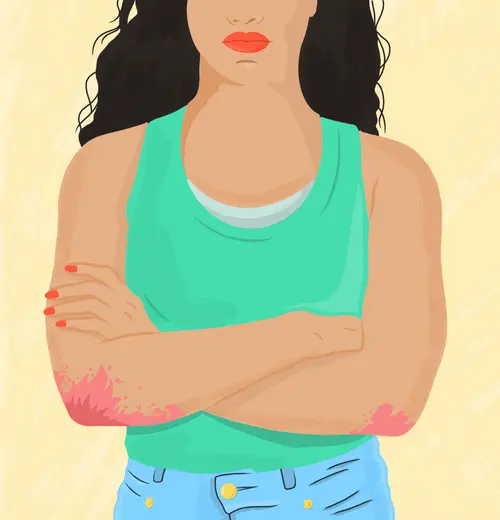If you have psoriasis, you may have tried many treatments to cure it. But first-line topical treatments such as steroids or coal tar may have not been enough, and you may be reluctant to try oral or IV medications such as biologics due to worries about side effects.
In these cases, a type of treatment called Goeckerman therapy may be appropriate.
What Is Goeckerman Therapy?
Goeckerman therapy is a well-established, very effective treatment for a certain type of psoriasis known as plaque psoriasis (the most common form of this disease). It involves the use of coal tar and phototherapy with ultraviolet B light. Both are often used independently to treat plaque psoriasis, but when they’re combined, they seem to be even more effective.
Goeckerman therapy has been around for almost 100 years, since 1925. It’s the brainchild of William Goeckerman, a physician at the Mayo Clinic who stumbled upon the combination of UVB light and crude tar for psoriasis. Patients were hospitalized and coal tar cream was applied to their psoriasis patches for 24 hours. The tar was removed with olive oil. Then, they were exposed to UV light, followed by an oatmeal bath. This regimen was repeated daily.
The results were shockingly effective; so much so, that the practice became widespread. Goeckerman himself was reportedly surprised at how popular it became.
Does Goeckerman Therapy Work?
Studies suggest that it does. While there hasn’t been too much research done on this topic, a study conducted at the University of California, San Francisco, and published in 2013 in the Journal of Visualized Experiences found that every patient on the Goeckerman therapy saw their psoriasis improve by at least 75% by 3 months. In comparison, biologics, a gold standard for moderate to severe psoriasis, only achieve similar results in about two-thirds of all patients. It’s also been shown to work among people whose psoriasis didn’t respond to either phototherapy, or medications.
While the Goeckerman therapy was initially invented to treat psoriasis, a modified version has also been created to treat other skin disorders such as eczema and pruritus (uncontrollable itching).
Is Goeckerman Therapy Safe?
Yes. Unlike medications commonly used to treat psoriasis, such as methotrexate or biologics, this therapy doesn’t suppress the immune system. The use of UVB light may raise your risk of skin cancer, however. Research shows that people with psoriasis who undergo more than 350 phototherapy sessions have a significantly increased chance of developing develop basal cell or squamous cell carcinoma, two common forms of skin cancer. It’s unclear whether or not it’s linked to an increased risk of melanoma. Because of this, you will need to be monitored closely by your dermatologist for skin cancer. It may also lead to premature aging of the skin.
How Is Goeckerman Therapy Done?
First, a dermatologist will do a physical exam. Then they will take a medical history, where they will find out what medications you take, how you’ve responded to past psoriasis treatments, and if you’ve ever had a bad reaction to sunlight or phototherapy. They’ll also check to make sure that you don’t have erythema, a skin condition that can cause intense reddening.
Once they’ve cleared you, they’ll start the treatment. This includes:
- Daily morning phototherapy with UVB light. How much you get depends on your skin type, and how you respond initially to phototherapy.
- After phototherapy, your doctor will apply an ointment that has 2% coal tar to psoriasis plaques on your body. Over time, they’ll increase the strength of the tar, from 2% to 5% and then finally to 10%. This will give you better results.
- If you have very thick psoriasis plaques, your dermatologist will use coal tar mixed with salicylic acid, a skin exfoliant which will help reduce plaque scaling.
- You’ll keep these topical medications on your skin for at least 4 hours, before washing it off with mineral oil and soap.
- Your dermatologist may also give you creams to use at home.
- You’ll be assessed every day by doctors for burning or itching. These sensations may mean the light therapy or tar are too strong. Your dermatologist will decrease one or both treatments. You may notice that different parts of your body respond differently to light therapy. Your doctor can adjust the UV dose for different areas.
You’ll do this everyday until your psoriasis has cleared. Once that’s happened, you’ll do outpatient phototherapy 3 times a week for the first month, tapering down to once a week. You’ll also be given ointments to use at home, usually steroids such as triamcinolone or clobetasol.
Most people see complete resolution of their psoriasis after between 20 and 30 sessions. You can expect to stay symptom-free for about 9.5 months. If you have severe psoriasis, you may need to go through this treatment once a year.
Where Can You Find Goeckerman Therapy?
Unfortunately, there are only a handful of centers in the United States that offer a formal Goeckerman therapy treatment program. The main one is at the University of California, San Francisco. There have been reports of patients trying a homemade version on their own, with a combination of sunlight and over the counter coal tar, but that’s not recommended. You can talk to your dermatologist about possibly doing a modified form of Goeckerman therapy in their office.

